There is a box in the RBGE Archives marked ‘Granny’ which usually begs the question of what’s inside? The following blog, researched and written by RBGE Garden Guide Rachel Thomas, answers this:

I first encountered ‘Granny’, a strawberry sea anemone, during a visit to the House of the Binns , near Linlithgow, in June 2023. The house was the property of the Dalyell family but is now in ownership of the National Trust for Scotland (NTS). The NTS guide pointed ‘Granny’ out in a nineteenth century portrait of Sir John Graham Dalyell (below) and explained that after a long life she died at the Royal Botanic Garden Edinburgh (RBGE). As an RBGE Garden Guide I was curious. Why should a sea anemone – an animal, not a plant – be curated in the botanic garden, why was she depicted in a portrait of a distinguished nineteenth century gentleman and what happened to her? On making an enquiry at the Garden archives, I discovered there was a file dedicated to ‘Granny’ – were the answers to my questions inside?
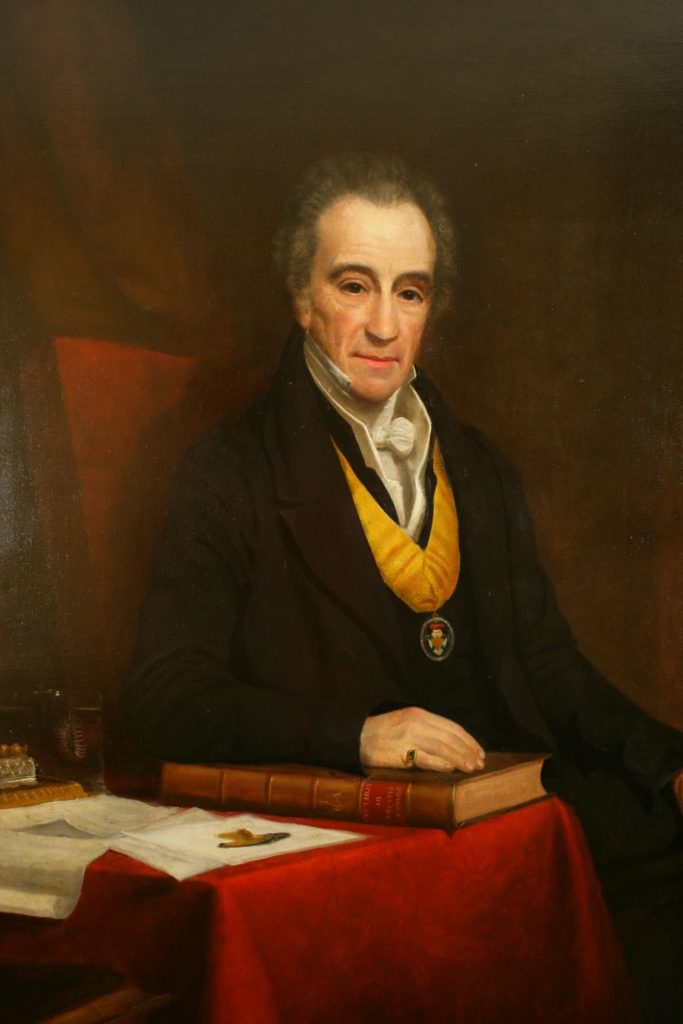
‘Granny’ was a strawberry or beadlet sea anemone, Actinia equina (one of several colour varieties of A. equina, although the taxon may be a complex of cryptic species), collected by Sir John Graham Dalyell from the shore of the Firth of Forth at North Berwick in 1828 where the species is common. Sir John, an Edinburgh advocate, also had a passionate interest in natural history especially marine biology. He was knighted in 1836 and succeeded to the baronetcy of Binns with its ancestral home The Binns, in 1841. Dalyell looked after Granny from 1828 until shortly before his death in 1851. She lived in a small aquarium, received regular changes of sea water (fresh sea water was collected from the Forth several times a week) and was fed half a mussel once a month (Swinney 2007).

Why ‘Granny’? Sea anemones are probably phasic hermaphrodites meaning individuals have gonads of both sexes, although the male phase may be short lived, although this remains unclear (Swinney 2007). Over about 20 years in Dalyell’s care, Granny produced about 334 young, many of which were deformed; then in the spring of 1857 Granny gave birth to 240 living young in one night, in August 1872 to 30 young and to another nine in December that year. She continued to reproduce each successive year until her death (Swinney, 2007). Hence the name ‘Granny’, and it stuck.
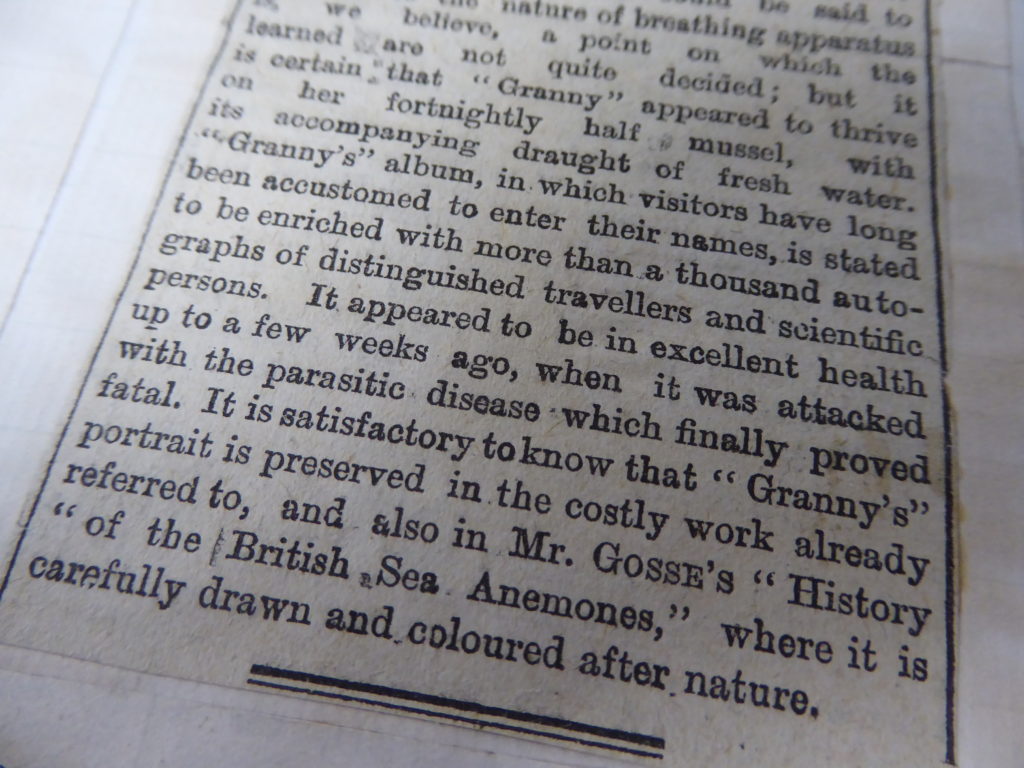
After Sir John’s death, Granny passed through several hands until in 1879 she came into the ownership of John Sadler (1837-1882) and then Robert Lindsay (1846-1913), successive Garden Curators at RBGE. From the 1850s onwards successive custodians had exhibited her at scientific exhibitions and conferences and she remained a focus for visitors in all the places she resided. Over the years she became so well known that her obituary was published in the Scotsman on 11 October 1887 (delayed for over two months in order to not detract from Queen Victoria’s Golden Jubilee) and was quoted as an example of longevity and fecundity – although how representative this is for wild sea anemones is not clear.
The Visitor Book
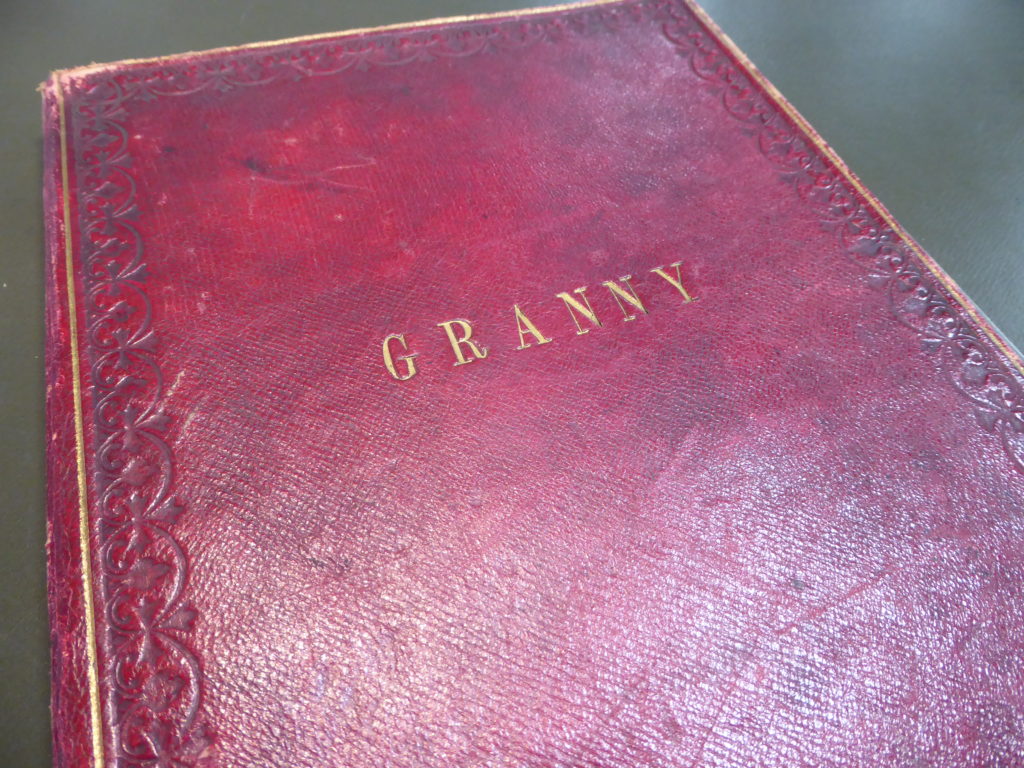
In the 1870s, access to the Gardens was through the Curator’s house. John Sadler opened a visitors’ book, embossing the name Granny on the front page, and recorded at least some of those who visited between 18 September 1879 and 2 August 1887 – a period of nearly 8 years when there is otherwise a gap in the record of numbers of visitors to the garden.
Granny’s visitors
Who were Granny’s visitors, and do they tell us anything about who was visiting RBGE in the mid to late nineteenth century?
There are over 1000 entries in the Visitors’ book. Eight years previously, between 1 January 1870 and 31 December 1878 there were over 700,000 visitors to the garden so the records of those visiting Granny is probably only a small proportion (G. Hardy and A. Taylor pers. com.). Most of those who signed were presumably visiting the garden for a general visit or for a specific horticultural or botanical purpose – although for some Granny may indeed have been their focus.
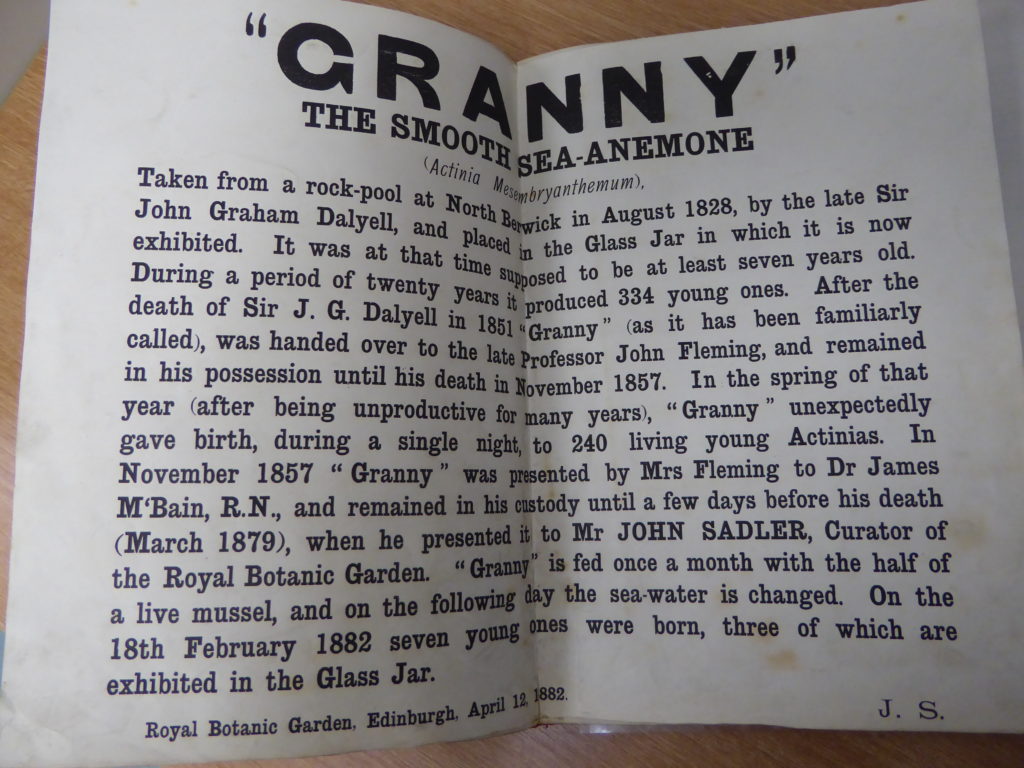
I have transcribed and recorded on a spreadsheet with an entry and page number i.e. entry xxx pyy, as many of the names and addresses as I can read. With help from Graham Hardy, Leonie Paterson and simple internet searches (links saved on the spreadsheet) I have found out a little about some of the well-known and less well-known visitors, but there are still some gaps and others are probably open to correction and alternative interpretations. What follows is a general overall summary and mention of some of the more notable, and easy to identify, names which gives a flavour of the sort of people who were visiting RBGE in the 1880s. There is much more that could be done.
Most visitors are Edinburgh people – many with addresses in the more well to do parts of the New Town and the emerging Victorian suburbs, although there are addresses from all over the city.
Some visitors came as small parties from the grand city residences where they were probably distinguished guests – e.g. in a party from Holyrood House with Lord Aberdeen and Lady Ishbel Aberdeen in May 1881 (209-215, p9) and another with Lady Ruth Bailey, the daughter of the Earl of Haddington, in May 1883 (819-823, p35); from Hopetoun House in June 1880 (131, p6) and April 1882 (428-429, p17) and from Dalmeny Park in November 1880 (173-174, p7). Other visitors were employed on these estates e.g. Christopher Chouler, Park Keeper, Dalkeith Park in May 1883 (818 p34) and also possibly earlier in June 1882 (739, p30). There were also visits by military personnel and their families based at Edinburgh Castle e.g. in 1881 (248, p10 and 283 p11).

There were visits by several notable Edinburgh figures e.g. Sir Thomas Jamieson Boyd, Lord Provost in 1882 (415, p17), a John Murray (282, p11), possibly the oceanographer, who lived at Challenger Lodge, Trinity only 15 minutes’ walk away who visited on 26 July 1881, Stevenson Macadam, April 1882 (403, p16), an academic and consulting chemist associated with various Edinburgh institutions, and also in April 1882 the family (434/435, p17, 440/441p18) of Thomas Bond Sprague, an actuary and mathematician then Chief Executive of Scottish Equitable Life Assurance Society. Clement Wragge and his wife Leonora D’Eresby-Wragge who had established the meteorological observatory on top of Ben Nevis comparing the weather at sea level with that on the mountain top visited on 16 Nov 1881 (350/351 p14). He subsequently established the Meteorological Office in Australia. Walter Elliot who was born in Edinburgh served as a civil servant in Madras, India where he had additional multiple interests including botany, zoology, Indian languages, numismatics (study of coins, banknotes and medals) and archaeology. He retired to Wolfelee, Borders to continue his research and served as President of the Botanical Society of Edinburgh (now Botanical Society of Scotland) 1869-70. He visited Granny in April 1882 (404 p16).
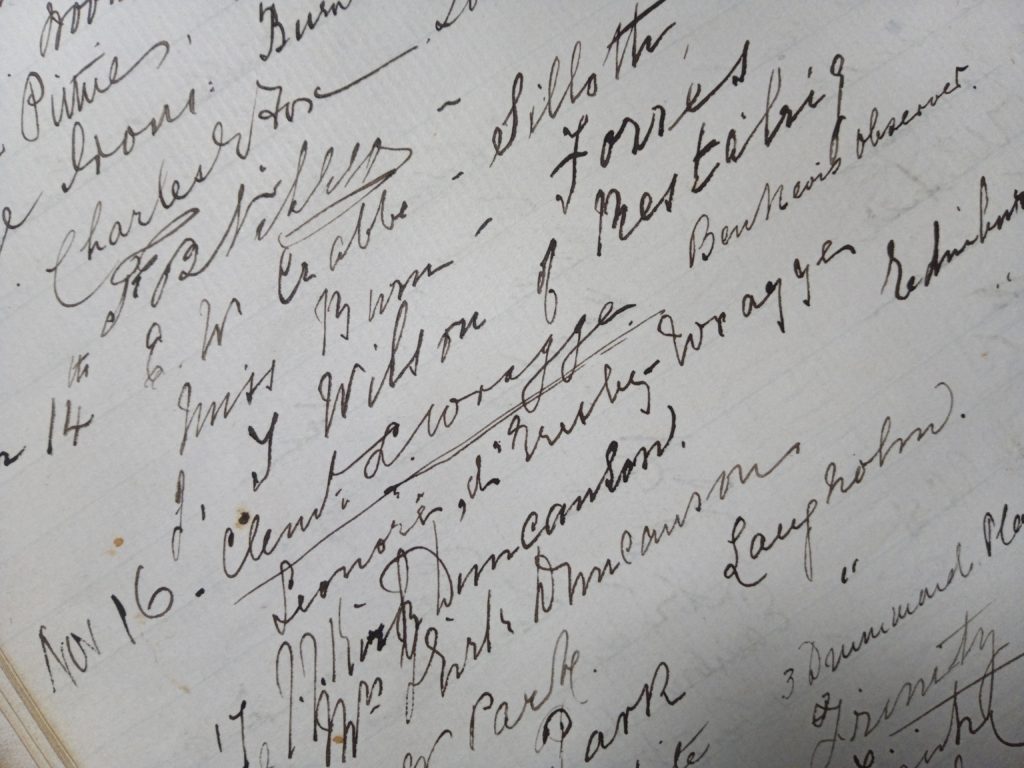
There were of course also those particularly associated with the Garden itself including the Balfour family. Isaac Bayley Balfour who visited on 5 October 1879 (11, p1) was Professor of Botany at the University of Glasgow from 1879-1884. Subsequently, his father John Hutton Balfour (1808-1884), Regius Professor of Botany in the University of Edinburgh and Regius Keeper of the Royal Botanic Garden Edinburgh who he succeeded visited with his family in July 1881 when they were living in Inverleith House (267, 277 and 279, p11).
There are probable relatives of RBGE Curators, James and William McNab e.g. E McNab, August 1881 (302, p12), Margaret McNab (322, p13).

W.T. Oldrieve, H M Office of Works, Edinburgh possibly on a professional visit in connection with repairs to RBGE buildings on 11 May 1885 (924, p39). A.D.(844 p36) and C. (860 p 36) Richardson who gave their address simply as Royal Botanic Garden visited in October 1883 and March 1884. In 1883 Adam Dewar Richardson oversaw the Arboretum at RBGE.
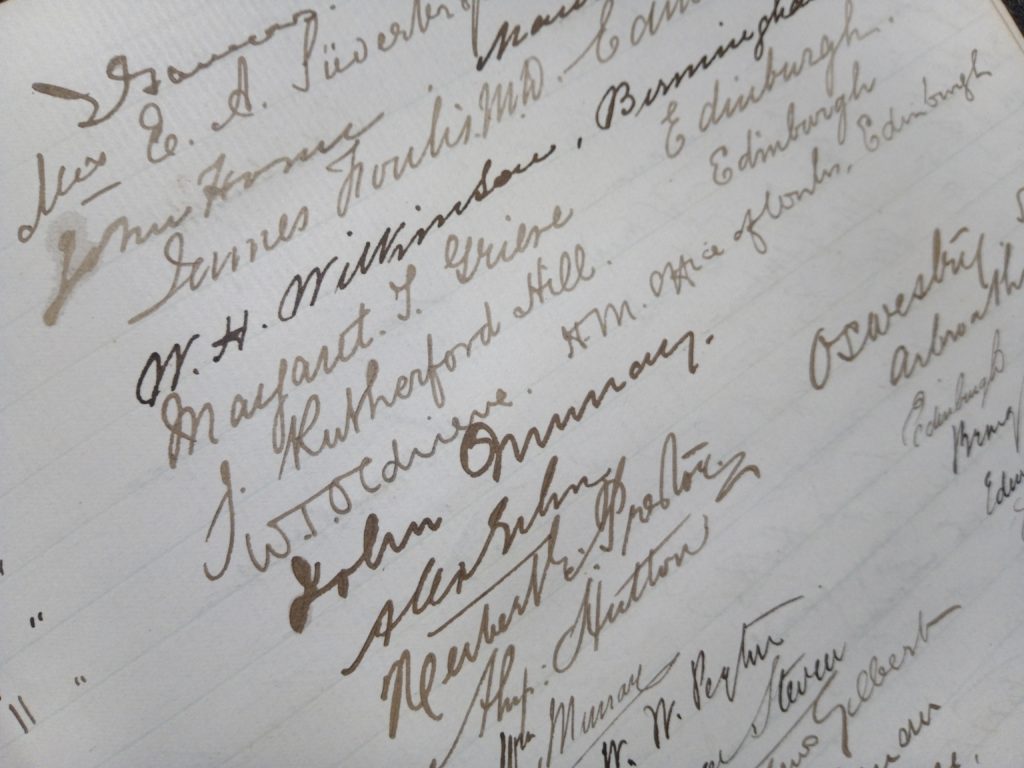
Local horticulturalists who visited included Frances Hope, Wardie Lodge, Trinity who either came on several occasions or sent family or friends staying at Wardie Lodge e.g. on 2 Dec 1879 (41 p2), 7 June 1881 (230, p9), and early in 1886 (993, p42); Robert Hutchison, President Royal Scottish Arboricultural Society, visited from Carlowrie, Kirkliston on 7 October 1879 (17 p1) and again on 22 July 1881(269 p11); John Garrett, Head Gardener at Whittingehame, East Lothian (1051 p54) on 23 December 1886 and on 23 March 1883 James Grieve, remembered for breeding of violas, pinks, carnations and especially apples (814, p33).
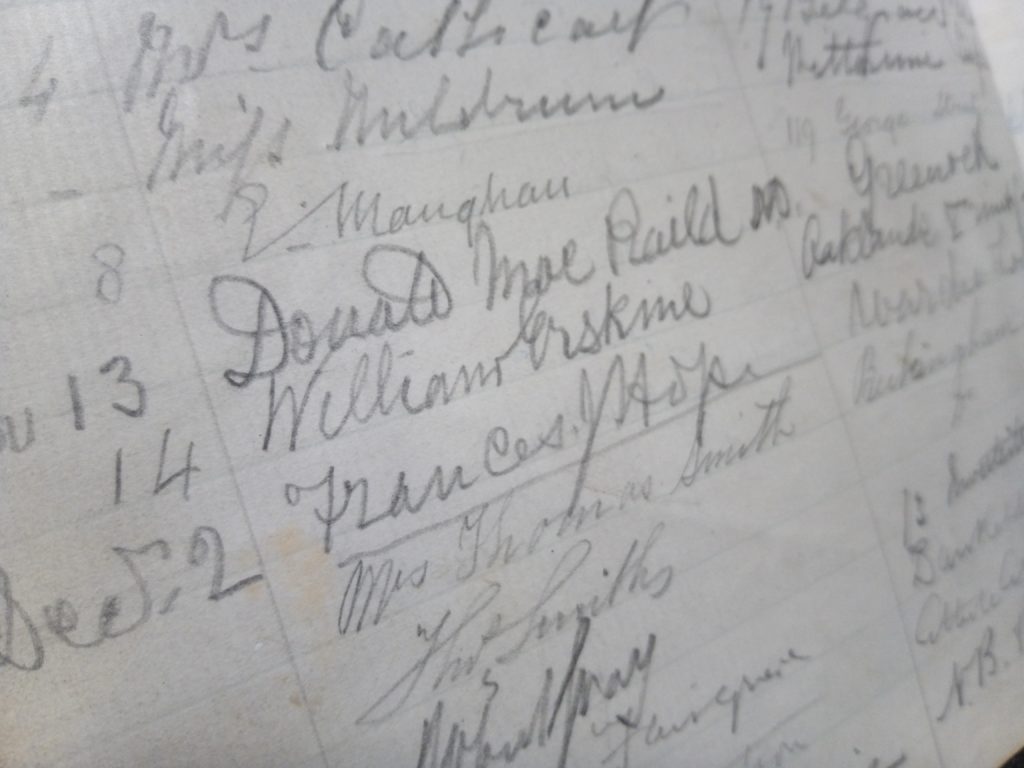
Visitors from other UK gardens and nurseries included John Ewing, Sheffield Botanic Garden on 23 Sept 1879 (8 p1) and again on 9 September 1882 (792 p33), Richard Lynch from Cambridge Botanic Garden on 16 July 1883 (832 p35) and from Dublin Botanic Garden the family of F.W. Moore on 21 August 1884 (887 p37) and then F.W. Burbidge and party in October 1885 (969 p41); Adolphus Kent, Royal Exotic Nursery Chelsea, author of Veitch’s Manual of the Coniferae came on 14 October 1884 ( 890 p37).
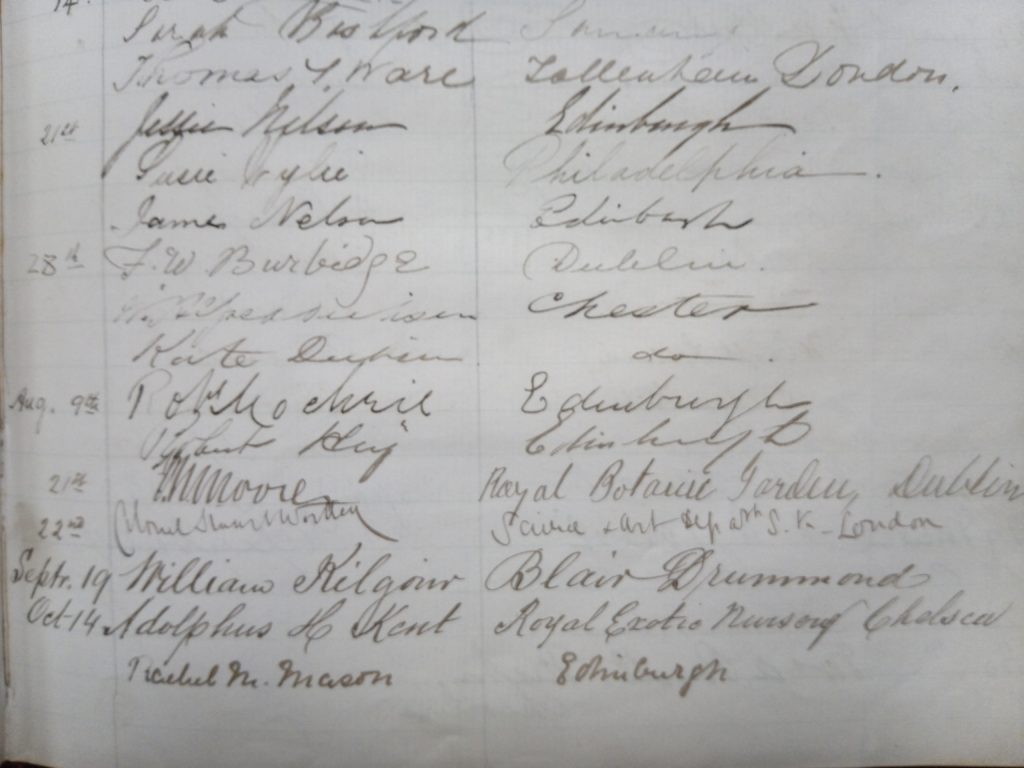
From further afield, visiting horticulturalists included John Horne Director Botanic Garden Pamplemousses, Mauritius on 10 June 1880 (103 p5) and again in April/May 1885 (919 p39) and Francis Neville Reid who established the Villa Rufolo Gardens at Ravello came on a trip back to Edinburgh in July 1885 (943, p39). Gustav Mann, a German botanist who undertook expeditions from Kew to West Africa and Darjeeling, India visited in June 1887 giving his address as Darjeeling, Assam (1097, p46). Henry Trimen, Director Royal Botanic Gardens Ceylon at Peradeniya visited on 11 Sept 1886, apparently with Frederick Orpen Bower, Professor of Botany at Glasgow University. (1139 p44).
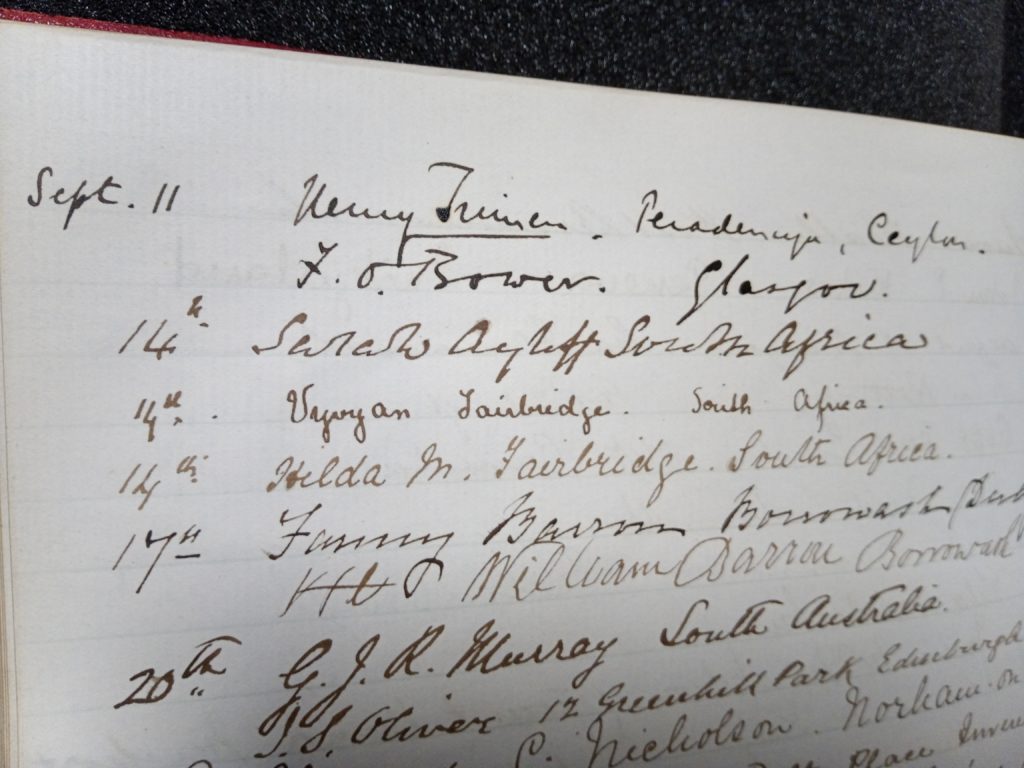
General visitors came from across Scotland – from Fife e.g. Burntisland (Mr and Mrs William Inglis, 150 & 151 p6, 26 August 1880), Kirkcaldy (Alec Justice and family, 771 p 32, July 1882), St Andrews (W O Lonie 273, p11, 25 July 1881), Cupar (Miss Melbourne, 37, p2, 4 Nov 1879), from East Lothian e.g. Whittingehame (John Garrett, Gardener, 1051 p54, 23 December 1886) the Borders e.g. Peebles (Mrs Schultze and Miss Beaton 840/841 p35, August 1883, from Glasgow e.g. (Jessie Baird, 809 p33, 10 March 1883), the Clyde e.g. Greenock (39, p2, 13 Nov 1879, Donald MacRaild MD) and west coast e.g. Ayr (Mr and Mrs Thomas Smith, 42 & 43 p2, 2 Dec 1879) Aberdeenshire e.g. Aberdeen (John Laing and John Mutch,178 & 179 p7, 30 Nov 1880), Forres (Rev James Keith, 97, p4, 1 June 1880), Aberchirder (Mr and Mrs J and Helen McRaith,142 &143 p6, 30 July 1880), Perthshire (James Crighton of Inchture, 868, p37, 24 May 1884) and up the east coast e.g. to Wick (George Kelly, 159 & 160, p7, 15 Sept 1880), Shetland (Peter W …., 206, p8, 16 February 1881) and even South Uist (Rod McDonald, 91, p4, 21 May 1880).
There are quite a few visits from clergy and their wives from Scottish manses e.g. Rev Thomas D Kirkwood, Dunbarney Manse, Bridge of Earn (93, p4, 21 May 1880) who may have been the Minister who officiated at John Sadler’s marriage to his first wife Mary Drummond in 1861, James Keith the Minister of Forres (97, p4, 1 June 1880), and in 1882 the Barty family possibly from the Manse at Kirkcolm, nr. Stranraer (737 and 738, p30, June 1882). Clergy from south of the Border came too. In 1882 a visit from Rev J.W. Lewis of the Vicarage at Norbiton, Kingston upon Thames (784, p32, 26 August 1882) and 1883 from Rev Dr Pigou of Halifax in Yorkshire (852, p36, Oct or Nov 1883) reflecting the interest in natural history of many Victorian clergy.
This interest, or indeed Granny’s fame, triggered a visit in 1882 by a sizable number of secondary school children from the then Daniel Stewarts School (boys) and what was then known as Queen Street School (girls) which became Mary Erskine. The boys included some cheeky youngsters; one who only signed himself as Ginger (entry 477, p19), one James McAdam chose to sign himself Jacobus Filius Adamus (entry 547, p22) while another entered as Ally Sloper (691, p28) a character who appeared in one of the first British comic strips in 1867!
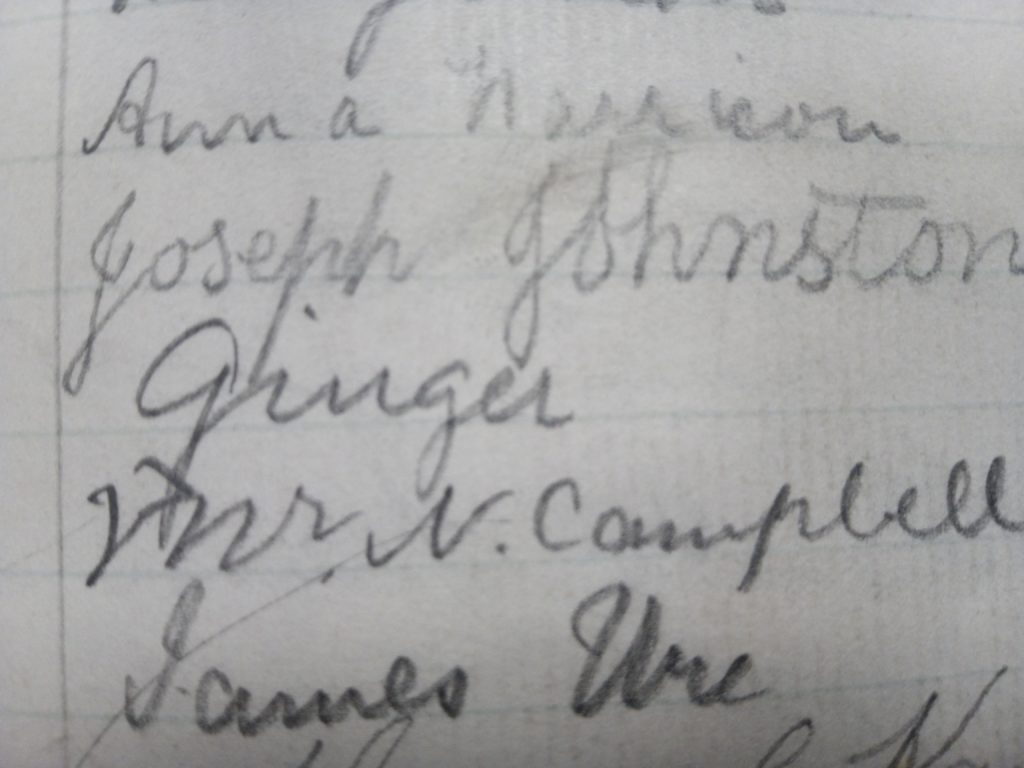
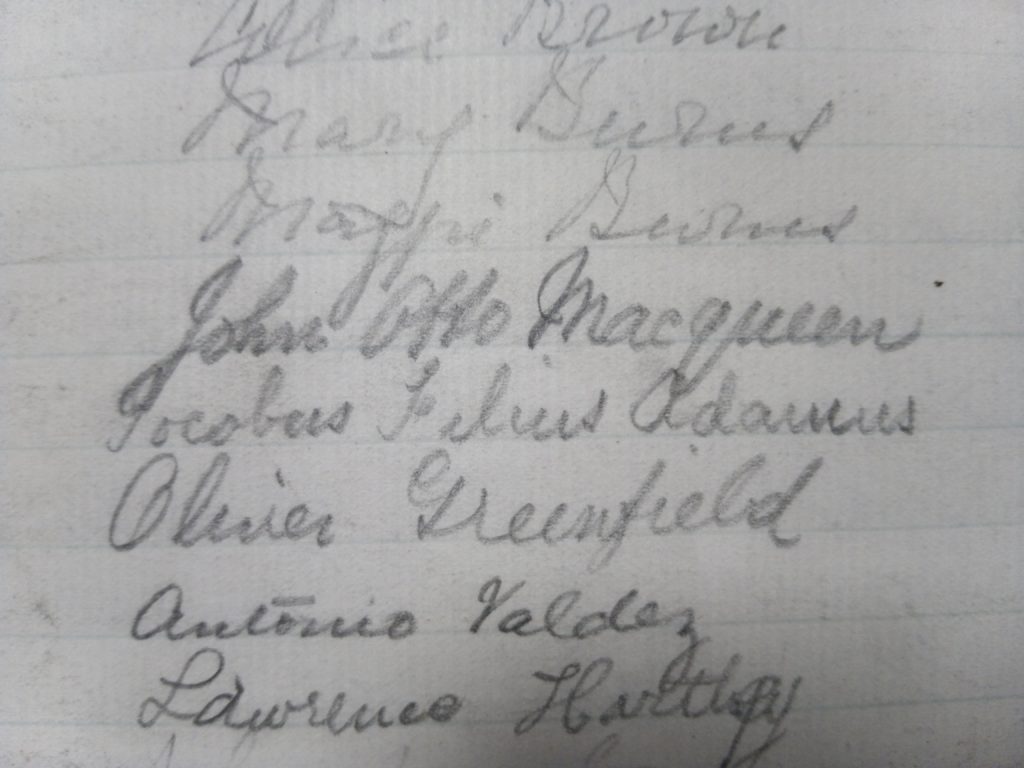
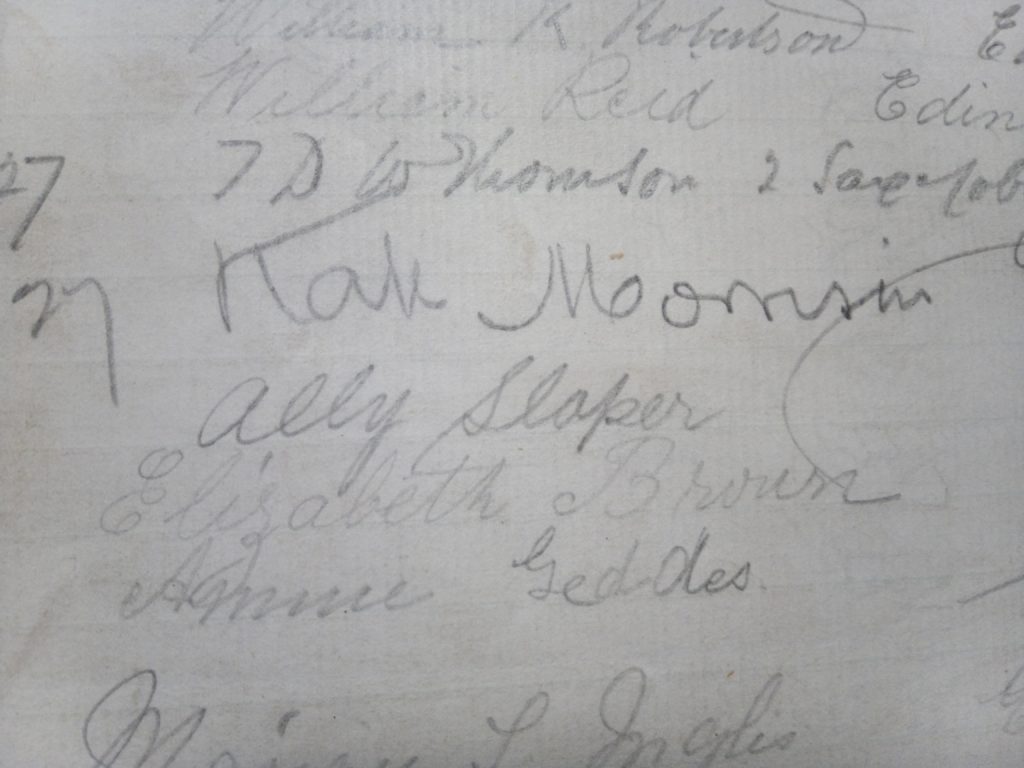
There were English visitors too from all parts of the country. William Ogle, a medic who trained in Edinburgh but whose career was in Derby, visited with his family in August 1881(298-301 p12). Richard Temple, The Nash, Nr Worcester visited in October 1881 (331 p13) on his retirement from the Indian Civil Service. He may have come with Robert Hutchison, Carlowrie, in connection with the Scottish Arboricultural Association, to visit relatives of his second wife a member of the family of the Earls of Crawford and Balcarres or indeed wider connections established through the Indian Civil Service.
The more general visitors may have been on holiday, exploring the capital, reliving student days, visiting family or on business in Edinburgh taking a break in the Botanic Garden. The following provides a flavour: 26 August 1881 Maggie C. Sutter from Newcastle (308, p12), a party from Lancaster in June 1881 (236-240, p 10), J. Headley Neale from Skeffington, Leicestershire on 26 May 1881 (224, p9,) Herbert? G. Preston from Oswestry, Shropshire in 1885 (927 p39), Lawrence Hartley on 22 April 1882 who gave his address only as London (550, p22), the Baldey party from Southsea, Hampshire in July 1881 (253-255, p10) and P. Chare, Dunean House, Torquay in June 1883 (827, p35).
There were several Irish visitors mostly from Dublin associated either with the University or Botanic Garden as above e.g. Professor Arthur Hill Curtis (Professor of Mathematics) and his wife on 24 September 1885 (964/965 p40), on 24 April 1886, Prof Alfred C. Haddon who gave as his address, Professor of Zoology, Royal College of Science, Dublin (1002, p42).
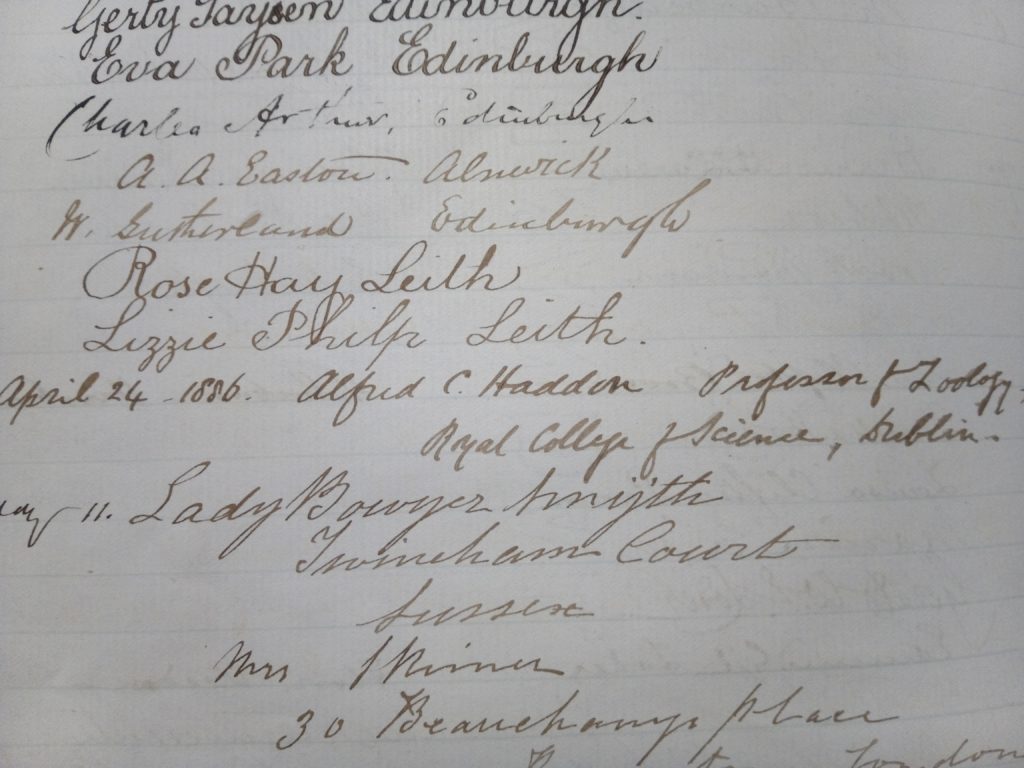
There were a small number of international visitors. G Lindstrom from Stockholm accompanied by William A. Macfie from Lysekil, Sweden who visited on 12 April 1882 (394/395 p16) may have had a particular interest in the invertebrate fauna of the Baltic. Anton Dohrn the founder of the first zoological research station (Stazione Zoologica) in Naples visited in September 1881 (319 p13). G J R Murray who gave his address only as South Australia visited on 20 September 1886 (1046 p44). He was the Chief Justice of South Australia but was educated in part at the Royal High School, Edinburgh, Cambridge University and elsewhere, while R. E. Minchin, the first curator of Adelaide Zoo, gave his address on 17 April 1887 as Director of Zoological Gardens, Adelaide, S. Australia (1067 p45). Also returning to Edinburgh was Dr Robert Gunning, who visited on 24 October 1882 (801 p33). He was an anatomist and church reformer who emigrated to Rio de Janerio, but returned to Edinburgh in1882, died in London in 1900, but is buried in Edinburgh’s Grange Cemetery.
There are probably many other interesting accounts associated with the international visitors. European visitors included from Reykjavík (G Lambertsen, 29 April 1882, 709, p29), Leyden (A.A.W. Hubrecht, Sept 1881, 320 p13), Geneva (John E. Kuhne, 20 July 1886 1014, p43), Brussels (Mrs Wavrin?, Bruxelles, 5 Sept 1880, 157 p7), and Flottbeck in Germany (John Booth and John Booth Jr. 18 Nov 1882 803/804 p33). However, some ‘European’ visitors need to be considered carefully as Antonio Valdez, from Lisbon on 22 April 1882 (549, p22) and Alexander Mercer from Paris on the same day (553 p22) may be two of the fictitious entries by the boys from Daniel Stewarts who came with their classmates.
The Scots travelled widely in the nineteenth century within the British Empire, the military and with a view to establishing a new life overseas. It’s not surprising therefore that there are visitors as listed below from the USA, Canada, Australia, New Zealand, South Africa, Brazil, Mauritius, India and the final entry from China. George Phillips, Her Britannic Majesty Consul, Foochow, China and his wife visited on 2 August 1887 (1108/09 p46) two days before Granny’s death on 4 August 1887.
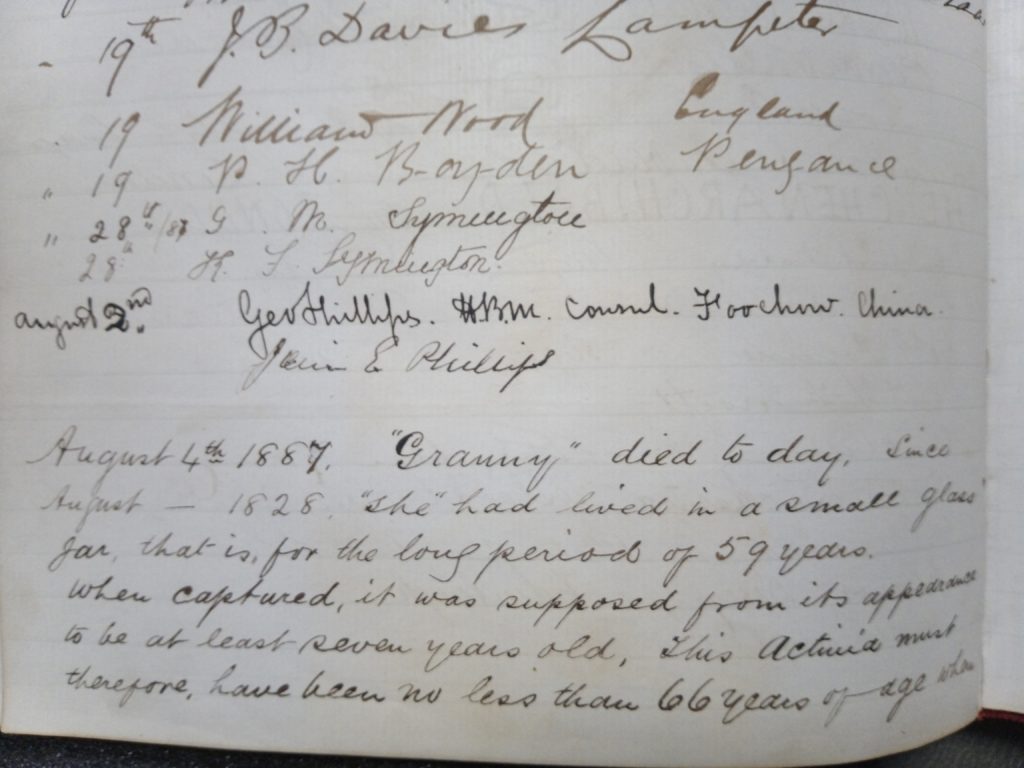
USA – Mary MacDonald and H. R. Crowell, New York City, 26 July 1881 (280/281 p11); E. W. Manson, New York, 26 August 1881 (309 p12), Hawaii (416 p17); G. F. Shiels, San Francisco, California 3 June 1882 (736 p30); C.I. Ireland, Boston 18 July 1883 (833 p35); Susie Wylie, Philadelphia, July 1884 (880 p37)
Canada – N. and John Lindsay, Georgetown, Ontario, Canada May/June 1884 (872,873 p37); J Lindsay M.D., Toronto, 29 July 1885 (950 p40); Edith and J. M. Brown, Toronto, 11 Dec 1885 (990/991 p41); Robert and Mrs Reid, London Ontario, July 1886 (1017/1018, p 43); Mr and Mrs George Brown, Toronto, Feb/March 1887 (1058 p44)
Australia – J. M. Frank Christian, T.J. Henry, Sydney N.S.W. – 242/243 p10, 13 June 1881; J. Douglas Ramsay, Melbourne, 3 Dec 1883 (855, p36)
New Zealand – Ernest Robertson, Auckland, N.Z., 10 April 1882 (390, p15); William Martin, 28 May 1886 (1005 p42)
South Africa – A. Davison, Kimberley, South Africa, 20 July 1881, 263 p11; G. Smith, Stellenbosch, Cape of Good Hope, 22 April 1882 (583 p23); David Williamson, King William’s Town, SA 20 Aug 1885 (955 p40); Hilda M. Fairbridge, Vyvyan Fairbridge and Sarah Ayliff, 14 Sept 1886, SA, (1041-1043 p44) and then Brenda T. Fairbridge 14 May 1887 (1074 p45)
India – R. A. Todd, Assam, India Oct/Nov 1881, (340 p14)
Exploring all these connections has been great fun, and there are probably many more interesting stories to tell. I hope I have made Granny’s visitors book a bit more accessible to those researching RBGE in the nineteenth century and Edinburgh more widely. Most of the visitors are local people and I’ve not been able to explore their interest in Granny or the Garden at all. For anyone interested in the history and development of Trinity, locating all the named villas mentioned from this suburb and researching their residents’ interest in Granny might be rewarding and it would be particularly fascinating to know whether any of the children who visited with Daniel Stewarts or Mary Erskine were inspired by their visit to take up careers in zoology, marine biology or indeed botany as a result.
by Rachel Thomas.
Acknowledgements
I am particularly grateful to the help of Leonie Paterson, RBGE’s Archivist, Graham Hardy, Serials Librarian at RBGE, and Library Volunteer Anne Taylor and the National Trust for Scotland and their Guide at The House of the Binns who sparked my interest in summer 2023.
Geoffrey N. Swinney’s paper on Granny has been an invaluable reference. Swinney, G.N., 2007, ‘Granny (c.1821- 1887), “a zoological celebrity”‘, Archives of Natural History 34 (2): 219-228
